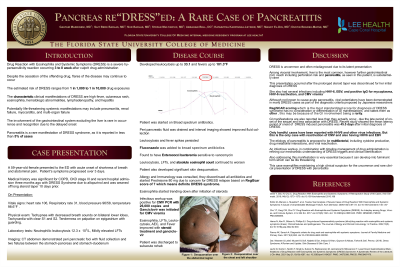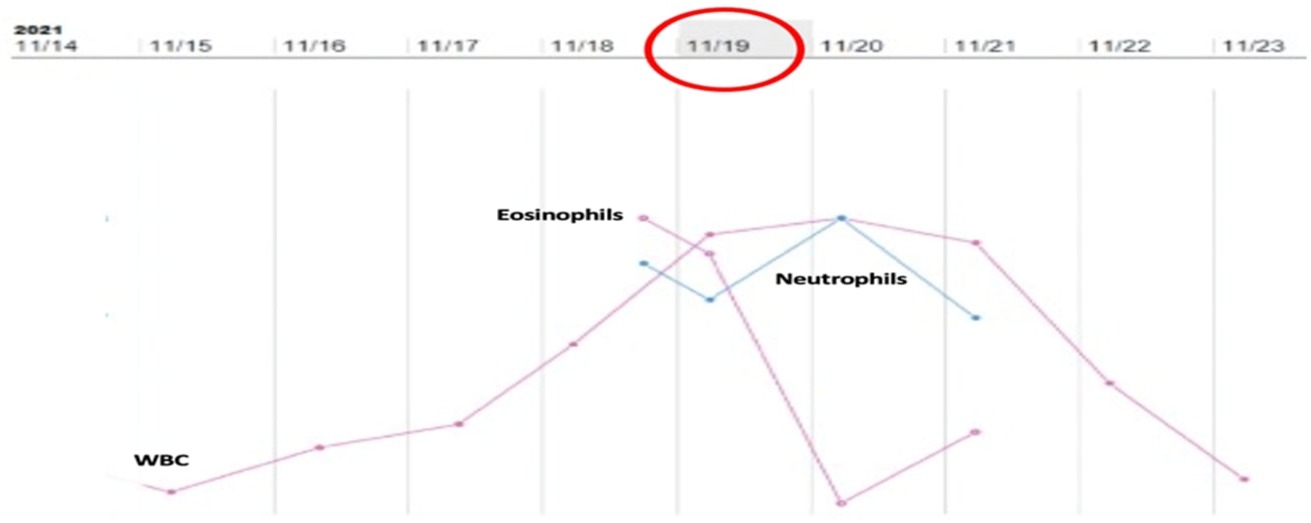Tuesday Poster Session
Category: Biliary/Pancreas
P2934 - Pancreas Re “DRESS” Ed: A Rare Case of Pancreatitis
Tuesday, October 24, 2023
10:30 AM - 4:00 PM PT
Location: Exhibit Hall

Has Audio

Nur Barlas, MD
Florida State University
Cape Coral, FL
Presenting Author(s)
Gautam Maddineni, MD, Nur Barlas, MD, Katarzyna Karpinska Leydier, MD, Augustine Salami, MD, Sait Barlas, MD, Kelsey Theriault, DO, Magdy El-din, MD
Florida State University, Cape Coral, FL
Introduction: Drug reaction with eosinophilia and systemic symptoms (DRESS) is a rare hypersensitivity drug reaction characterized by lymphadenopathy and eosinophilia. While liver involvement is the most common visceral manifestation, gastrointestinal complications, including pancreatitis, are uncommon. We present a case of a 59-year-old female with a history of DRESS complicated by pancreatitis who developed acute bilateral pulmonary emboli and subsequent complications during her hospital stay.
Case Description/Methods: The patient is a 59-year-old female who recently completed a steroid taper for a DRESS syndrome due to allopurinol and presented with acute bilateral pulmonary emboli. She developed sepsis due to gastric perforation and necrotizing pancreatitis. CT abdomen revealed peri pancreatic foci with the fluid collection and two fistulas between the stomach-pancreas and stomach-duodenum. Despite fluid drainage and interval imaging showing improved collection, the patient had persistent leukocytosis and fevers. Broad-spectrum antibiotics and fluconazole were administered, but leukocytosis, liver function tests, and eosinophil count worsened. All antibiotics were discontinued, and prednisone 80 mg was started due to suspected DRESS relapse based on increasing eosinophilia and skin desquamation. Eosinophilia trended down after steroid initiation. CMV viremia was detected, and the patient was eventually found to have HHV6, EBV, and mycoplasma. Ganciclovir treatment was initiated, improving liver function, leukocytosis, and fever. The patient was subsequently discharged to subacute rehab.
Discussion: DRESS is a rare condition often misdiagnosed due to its latent presentation. While liver involvement is common, gastrointestinal complications, including pancreatitis, are rare. This case highlights the development of pancreatitis after the completion of a steroid taper and the presence of multiple infectious factors. The Regi SCAR scoring system for DRESS does not include gastrointestinal manifestations, likely due to their rarity. The latency of DRESS-induced pancreatitis is approximately 45.5 days. Drug administration and infectious workup enhance our understanding of DRESS triggers and clinical identification. The etiology of pancreatitis, in this case, is likely multifactorial, involving cytokine production, drug metabolite interactions, and viral reactivation. This case emphasizes the importance of considering DRESS in patients with unique and rare clinical manifestations, including pancreatitis.

Disclosures:
Gautam Maddineni, MD, Nur Barlas, MD, Katarzyna Karpinska Leydier, MD, Augustine Salami, MD, Sait Barlas, MD, Kelsey Theriault, DO, Magdy El-din, MD. P2934 - Pancreas Re “DRESS” Ed: A Rare Case of Pancreatitis, ACG 2023 Annual Scientific Meeting Abstracts. Vancouver, BC, Canada: American College of Gastroenterology.
Florida State University, Cape Coral, FL
Introduction: Drug reaction with eosinophilia and systemic symptoms (DRESS) is a rare hypersensitivity drug reaction characterized by lymphadenopathy and eosinophilia. While liver involvement is the most common visceral manifestation, gastrointestinal complications, including pancreatitis, are uncommon. We present a case of a 59-year-old female with a history of DRESS complicated by pancreatitis who developed acute bilateral pulmonary emboli and subsequent complications during her hospital stay.
Case Description/Methods: The patient is a 59-year-old female who recently completed a steroid taper for a DRESS syndrome due to allopurinol and presented with acute bilateral pulmonary emboli. She developed sepsis due to gastric perforation and necrotizing pancreatitis. CT abdomen revealed peri pancreatic foci with the fluid collection and two fistulas between the stomach-pancreas and stomach-duodenum. Despite fluid drainage and interval imaging showing improved collection, the patient had persistent leukocytosis and fevers. Broad-spectrum antibiotics and fluconazole were administered, but leukocytosis, liver function tests, and eosinophil count worsened. All antibiotics were discontinued, and prednisone 80 mg was started due to suspected DRESS relapse based on increasing eosinophilia and skin desquamation. Eosinophilia trended down after steroid initiation. CMV viremia was detected, and the patient was eventually found to have HHV6, EBV, and mycoplasma. Ganciclovir treatment was initiated, improving liver function, leukocytosis, and fever. The patient was subsequently discharged to subacute rehab.
Discussion: DRESS is a rare condition often misdiagnosed due to its latent presentation. While liver involvement is common, gastrointestinal complications, including pancreatitis, are rare. This case highlights the development of pancreatitis after the completion of a steroid taper and the presence of multiple infectious factors. The Regi SCAR scoring system for DRESS does not include gastrointestinal manifestations, likely due to their rarity. The latency of DRESS-induced pancreatitis is approximately 45.5 days. Drug administration and infectious workup enhance our understanding of DRESS triggers and clinical identification. The etiology of pancreatitis, in this case, is likely multifactorial, involving cytokine production, drug metabolite interactions, and viral reactivation. This case emphasizes the importance of considering DRESS in patients with unique and rare clinical manifestations, including pancreatitis.

Figure: Trends of WBC and Eosinophils in hospital stay
Disclosures:
Gautam Maddineni indicated no relevant financial relationships.
Nur Barlas indicated no relevant financial relationships.
Katarzyna Karpinska Leydier indicated no relevant financial relationships.
Augustine Salami indicated no relevant financial relationships.
Sait Barlas indicated no relevant financial relationships.
Kelsey Theriault indicated no relevant financial relationships.
Magdy El-din indicated no relevant financial relationships.
Gautam Maddineni, MD, Nur Barlas, MD, Katarzyna Karpinska Leydier, MD, Augustine Salami, MD, Sait Barlas, MD, Kelsey Theriault, DO, Magdy El-din, MD. P2934 - Pancreas Re “DRESS” Ed: A Rare Case of Pancreatitis, ACG 2023 Annual Scientific Meeting Abstracts. Vancouver, BC, Canada: American College of Gastroenterology.
